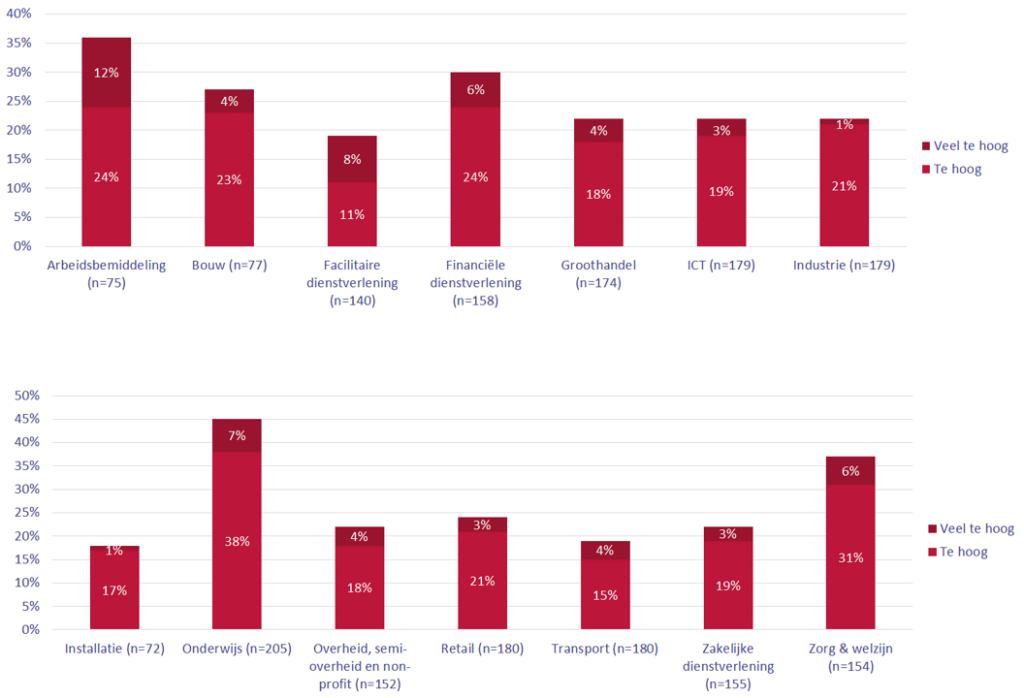What is the workload monitor like and how do I analyze the results?
Within your organization, the Integron workload monitor has been applied. This questionnaire roughly consists of four parts:
- The current workload experience
- KPIs such as enthusiasm (eNPS)
- Job demands and job resources
- Energy givers and energy consumers
You’ll find the results in your dashboard. We’ll go through them one by one and explain directly how to analyze the results.

Current Workload Experience
Naturally, employees were asked to rate their current perception of workload using the following scale: much too low, too low, good, too high, and much too high.
When reviewing these results, it’s common to wonder, “Is this good or bad?” and “Is this normal?” These are valid concerns. To put your results into perspective, it’s important to have a point of comparison.
The general advice is to avoid comparing apples to oranges. Ideally, compare your results with those from previous measurements or between different departments within the same organization. This approach provides a clearer picture.
However, if such comparisons are not possible, it can still be helpful to compare your results to those from other industries. Note, though, that such comparisons are not perfect and should not be overemphasized, as they are not entirely equivalent.
Below, you will find the percentages for “much too high” and “too high” workloads by industry. This data represents a broad view—choose the information that is most relevant to your situation.
We are currently working on translating the text in the images on our website. We appreciate your patience and kindly ask you to check back later for the updated content.

KPI’s
The workload monitor also assessed several KPIs, including enthusiasm (eNPS), pride, engagement, and application behavior. You can find explanations for these metrics below.
Before diving into the details, here’s an important note:
In your dashboard, you can compare employees who perceive their workload as good, too high, and much too high. This comparison is particularly useful for understanding the impact of workload on KPIs like enthusiasm. However, this comparison is valid only if there are at least 5 respondents in each group.
In our analysis within Working Netherlands, we observed that employees who view their workload as good are generally more enthusiastic (as indicated by eNPS), more proud, and more engaged with the organization compared to those who see their workload as too high or much too high. This indicates that workload significantly affects employees’ enthusiasm, pride, and commitment.
Additionally, our surveys reveal a clear correlation with absenteeism. Among employees who consider their workload to be good, only 7% reported being sick for more than 10 days in the past year. For those who find their workload too high, this figure nearly doubles to 13%. The percentage is even higher for employees who perceive their workload as much too high, reaching 19%.
Employees with excessive workloads not only have higher rates of absenteeism but are also more likely to leave the organization. Specifically, 69% of employees with a much too high workload plan to apply for jobs at other organizations within the coming year. For those with a too high workload, the percentage is 44%, while only 27% of employees with a good workload are considering leaving.
It is clear that enthusiastic, proud, and engaged employees are crucial for a successful organization. High absenteeism and turnover can incur significant costs. Therefore, it’s essential to recognize and address the impact of workload on these factors.
Employee Net Promoter Score (eNPS)
Globally, the Employee Net Promoter Score (eNPS) is a widely recognized method for measuring employee enthusiasm within an organization. The eNPS provides insights into employee enthusiasm using a single question:
“How likely would you be to recommend the organization as an employer to acquaintances?”
The underlying idea is that if employees are enthusiastic about their employer, they are likely to recommend it to friends and family.
The eNPS is measured on an 11-point scale, ranging from 0 (very unlikely) to 10 (very likely). Based on their responses, employees are categorized into three groups:
- Promoters (Scores of 9 or 10)Promoters are highly enthusiastic employees who actively recommend your organization to others. They are ambassadors of the organization, radiating inspiration and enthusiasm. These employees are often the driving force within your organization, open to change, and contribute to its growth. They proudly share their positive experiences and generally have low turnover and absenteeism. In short, promoters bring contagious energy and drive growth!
- Passives (Scores of 7 or 8)Passives are neutral in their perceptions. They are satisfied but not particularly enthusiastic. They do not actively recommend the organization but also do not speak negatively about it. Compared to promoters, passives show lower pride and commitment and have higher turnover and absenteeism rates.
- Detractors (Scores of 6 or below)Detractors are not enthusiastic and are usually dissatisfied with the organization. They often feel their needs are not addressed and are unlikely to show enthusiasm even with changes. Detractors are more likely to speak negatively about the organization, exhibit low pride and commitment, and have high absenteeism and turnover rates. Essentially, detractors demonstrate disengagement.
The eNPS is calculated as the difference between the percentage of promoters and detractors. This score indicates whether there are proportionally more promoters or detractors within the organization.
To better understand the reasons behind employees’ recommendations, a follow-up question is often asked based on their initial response.
Job Demands and Job Resources
The Integron workload monitor is based on Bakker & Demerouti’s well-established Job Demands & Resources (JDR) model. This model refines the concepts of carrying capacity and carrying load into the more specific terms of job demands and job resources.
- Job Demands refer to the various aspects of a job that require sustained effort and can lead to strain if not managed well. They are essentially the task demands placed on you by your job.
- Job Resources are the physical, psychological, social, and organizational aspects that help you achieve work goals, reduce job demands, and stimulate personal growth and development. They can be seen as the energy sources you need to handle job demands effectively.
An imbalance between job demands and job resources can result in increased workload and stress.
Job Demands and Job Resources: What They Are
Scientific studies indicate that job demands and resources can vary widely depending on the industry, organization, and individual. They can even overlap, with a job resource sometimes becoming a job demand and vice versa. Despite this variability, studies generally agree on several key factors that impact workload. These factors were rated by employees based on their experience and the importance of each item:
- Knowledge to do the job
- Skills to do the job
- Physical ability to handle the work
- Mental ability to handle the work
- Work-life balance
- Success in achieving the desired level of quality
- Information to do the job
- Variety of work
- Time available for work
- Clarity of job expectations
- Working environment (equipment/climate)
- Opportunities for development
- Alignment of personal and organizational values
- Collaboration with immediate colleagues
- Help and support from immediate colleagues
- Help and support from immediate supervisor
- Appreciation from immediate supervisor
- Feedback from colleagues/supervisor
Interpreting the Results
The JDR model suggests that for a positive workload experience, these factors should be in balance. When workload is perceived as too high, issues often arise in the following areas:
- Personal Factors (Items 1-6): These relate to the individual employee. Although some aspects are personal, managers can influence them positively. Consider having one-on-one conversations to identify how the organization can help.
- Work-Related Factors (Items 7-10): These factors are related to the work itself. Engage with the team to understand the issues behind low scores and collaborate on solutions. If needed, conduct additional individual discussions.
- Organizational Factors (Items 11-13): These are related to broader organizational elements. Discuss issues with the team and coordinate with HR, Facilities, or Management to address them. Ensure to provide feedback to the team.
- Team-Related Factors (Items 14-18): These issues involve team dynamics. Address these within the team and seek HR assistance if necessary.
Key Findings
From our research within Working Netherlands, several important insights have emerged:
- Time Management: Employees experiencing high work pressure often report insufficient time to complete tasks, leading to longer working hours and a disrupted work-life balance. A good work-life balance is crucial for recharging and maintaining mental health.
- Freedom and Expectations: Employees with high work pressure may struggle with setting priorities when they have significant freedom and unclear expectations.
- Help and Support: Insufficient help from colleagues and supervisors can exacerbate workload issues, making employees feel they must handle everything on their own.
- Appreciation: Lack of appreciation from supervisors can negatively impact motivation and self-esteem, increasing work pressure.
- Work Environment and Feedback: Poor work conditions and insufficient feedback can further strain employees. Feedback is crucial for understanding job performance and managing workload expectations.
- Values Alignment: A misalignment between personal and organizational values can create internal conflict, increasing work pressure.
Action Steps
To address high workload issues effectively:
- Clarify Expectations: Define the expected time and quality for tasks, and ensure employees know what help and support are available.
- Value Employees: Recognize and appreciate employees’ efforts. Personal recognition can be highly impactful.
- Improve the Work Environment: Assess and enhance resources, workplace conditions, and information availability.
- Encourage Feedback: Promote a culture of feedback through training and regular opportunities for feedback exchange.
- Align Values: Ensure that hiring practices and organizational values are in sync to avoid misalignment.
Priority Matrix
To further refine focus, use a priority matrix:
- Red Spheres: Important issues with significant room for improvement. Prioritize these areas for action.
- Green Spheres: Important issues with less room for improvement. These are your strengths to maintain.
For detailed insights into how these issues score within Working Netherlands, refer to our white paper on workload.
Energy givers and energy consumers
As we pointed out earlier, from the many scientific studies that have been done, there is no one definitive list of job demands and job resources. This can be industry-, organization- and person-dependent, and moreover, a job resource can also become a job demand at the same time. We therefore asked employees what gives them a lot of energy in their work, what costs them a lot of energy and whether this is balanced. This already gives you a good indication of how the workload is experienced. It is also often the case that when someone is too busy, he or she is not necessarily doing too much, but often doing too much of what does not give them energy.
Read the answers and discuss them with your team. What energizes the team and how can you work together to maximize and possibly increase it? What is within the team that takes a lot of energy and how can you as a team reduce this? And please note, we cannot stress it often enough, everyone is different. What gives one person energy, may cost someone else a lot. See this as an opportunity and see if you can help each other in this. Win win!